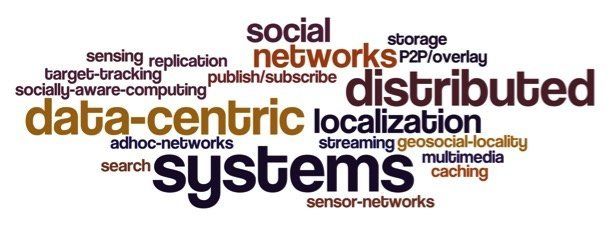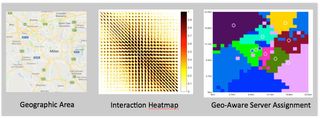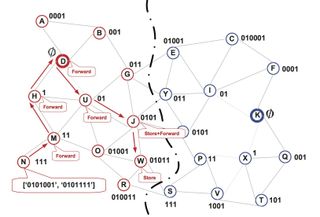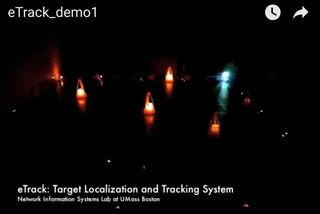

WigWag: Geo-Aware Server Architecture for Mobile Edge Computing
As mobile devices have become the preferred tool for communication, work, and entertainment, traffic at the edge of the network is growing more rapidly than ever. To improve user experience, commodity servers are deployed in the edge to form a decentralized mobile edge computing (MEC) network of mini datacenters each serving a localized region. This project is aimed to (1) design a scalable and adaptive connectivity architecture for the MEC servers, (2) deploy this architecture geographically and assign workloads to the servers for maximal offloading benefit, and (3) devise stochastic-modeling based algorithms to cope with time-varying workloads.

PME: Power-of-Metric Embedding for Network Dissimilarity Estimation
Network latency and packet loss rate in a computer network, social distance in a social network, or in general, any quantity indicating a node's remoteness from one another in a network, examples of network dissimilarity. The Network Dissimilarity Estimation (NDE) problem is: given sample measurements, how to compute the dissimilarity for any pair of nodes without more measurements. The geometric embedding approach to NDE assumes a linear relationship between dissimilarity and its intrinsic metric. We conjecture that this relationship follows a power law. The project is to validate and apply the conjecture to several practical applications.

DISCO: Dissimilarity-based Localization
Location fingerprinting, a range-free approach to GPS-free localization, requires a prior training set of fingerprints, each sampled at a known location, so that future fingerprints can be located by comparing to this set. Conventionally, the fingerprint space is defined as a feature vector space. In practice, it is hard to find a quality feature space robust to device heterogeneity and environment and infrastructure dynamics. We advocate a fundamentally different model where a fingerprint is defined as a dissimilarity measurement associated with a pair of locations. We propose a localization framework for this model based on Riemannian geometrical embedding.

SINFONIA: Distributed Query-Centric Storage, Indexing, and Networking
The mainstream approach to distributed data storage is essentially data-centric, aiming to preserve certain content relationships. We advocate the concept that data are not what their content is, but are what they are queried for. Consequently, we propose an approach that preserves query-centric relationships. In this era of big data, although huge data are generated, only a small subset of them is queried, hence useful. By adopting a query-centric approach, the optimization can focus only on the useful data, for the benefit of the queries. The project will involve all three crucial components: storage, indexing, and networking.
eTrack: Target Monitoring with Low-Cost Sensor Networks
We are interested in enabling techniques for target monitoring using low-cost sensor networks. A “sensor” is a small computing device that can read the environment and process information; it can be a mobile phone or an autonomous underwater vehicle with sensing capabilities, or typical sensors as in a conventional sensor network. We want to devise a solution that can tell us whether a special event of interest happens, when and where, quickly, accurately, and efficiently. Our contribution consists of a localization solution based on a novel hierarchical machine learning method using hop-count information only and a publish/subscribe solution allowing for quick and efficient notification when an event occurs.

PUB-2-SUB: Decentralized Solution for Content-based Publish/Subscribe
Traditionally, search services follow the request/response model in which the data must be stored first waiting to be queried. Publish/subscribe model allows for the data to be sent instantly to interested users. We have proposed a decentralized design for publish/subscribe services in P2P networks, ad hoc networks, and sensor networks. This design is based on an efficient content-based routing architecture and an effective filtering mechanism to minimize publication and subscription traffic redundancy. In a complex and decentralized world it could now be easier to get information located anywhere whenever it is available.

EZSearch: Fast and Efficient Data Retrieval in P2P Networks
How do we find information in a complex yet sharing world, without using a central agency such as Google? Nowadays, anybody, anywhere, virtually, can generate data thanks to advanced multimedia technologies. The search for useful information, however, remains challenging. In this NSF-funded project, we have developed a solution in which the network where the information is to be searched is efficiently organized in a decentralized manner. This design offers a networking architecture independent from the data and allows for deployment of multiple retrieval services that may differ from one another.

MobiVOD: Video-on-Demand Streaming in Mobile Ad-hoc Networks
We have proposed a design for streaming video-on- demand (VOD) to mobile ad hoc clients. MobiVOD, the proposed solution, can sustain client failure and mobility and provide true VOD services to most clients. MobiVOD combines (1) periodic broadcast from the media server to reach all the clients and (2) client caching to service late arriving clients. How to broadcast, who to cache, and what is cached are the research questions we addressed in developing MobiVOD.

Range Multicast: An Overlay Network for Interactive Video Streaming
Range Multicast is a shift from the conventional thinking about multicast streaming where every receiver must obtain the same data packet at any time. A "range" multicast allows new members to join at their own time and still receive the entire video stream without consuming additional server bandwidth. Range Multicast also enables video-cassette-recorder (VCR)-like interactivity. All this is possible thanks to the innovative use of network caching in Range Multicast. Clients enjoy better service latency since they can join an existing multicast instead of waiting for the next available server stream.

ZIGZAG: A Peer-to-Peer Architecture for Live Video Streaming
ZIGZAG is a P2P technique for single-source media streaming, which organizes the clients into a P2P tree rooted at the server. This tree's height is logarithmic with the client size and nodal degree constant-bounded. This helps reduce the hop-count on the delivery path to any client while avoiding network bottleneck. An efficient control protocol between the nodes must be in place to make the tree robust under network dynamics and client churns. In this aspect, ZIGZAG incurs only a constant amortized control overhead. Especially, failure recovery can be done regionally with minimal impact on the existing clients and mostly no burden on the server.


